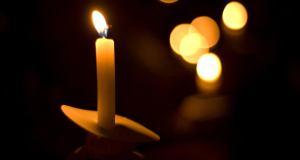This weekend, audiences will turn out to see an all-star cast in The Dead Don’t Die, which promises to be a zombie movie full of nods to the genre’s classics. The movie serves as a brilliant reflection of small town culture in the U.S., and while audiences may feel uncomfortable about what they see there, they absolutely must watch it.
The Dead Don’t Die is predicated on a massive global catastrophe, absurdly combining some of today’s biggest societal anxieties — climate change, corporate environmental practices and rising social and racial tension, among others. However, the story itself is confined to the town of Centerville, Pennsylvania, and it focuses only on how these massive problems affect the people there. To anyone who has lived in small, out-of-the-way town, they will be extremely recognizable.
Videos by PopCulture.com
The movie tells us what is really important to its story from the very start. It mocks the particulars of its premise with over-the-top explanation and laughable CGI. The unmitigated fracking of the earth’s crust has somehow shifted the planet’s poles, we are told, and the resulting celestial shift has ripple effects everywhere. This gives rise to “toxic lunar radiation” of some kind, which can raise zombies from the dead for reasons no one — least of all director Jim Jarmusch — seems interested in exploring.
In short: “total planetary destruction.”
Unlike so many newer zombie and catastrophe stories, however, this movie won’t take us anywhere near the White House, or some secret black ops laboratory, or even a city. We will simply watch the dead rise from the old church cemetery, the funeral home and the police holding cell in Centerville. We’ll watch them march back to their favorite haunt in town, going after their old habits with blind devotion and eating human flesh along the way.
As always with zombie movies, this is just the backdrop for the story between human survivors. We have a few interesting characters for that: Officer Ronnie Peterson (Adam Driver), Officer Mindy Morrison (Chloe Sevigny) and Sheriff Cliff Robertson (Bill Murray). The police are the key to understanding the allegory at work here — yet another bold statement in today’s political climate.
By the end of the movie the audience can probably only relate to Mindy. She is the only officer, perhaps even the only character to have a proper reaction to the onset of the apocalypse. Everyone else is either trapped in some degree of denial, or else is a little too willing to embrace their new, violent reality.
This might be the most realistic thing from a cast of characters who otherwise act strangely uninterested in the collapse of their world. The zombies are not the only ones tromping through life with their heads down. In the spirit of the genre, the cataclysm reveals the autopilot nature of modern life, asking and then quickly answering the question: who are the real zombies here?
The most exaggerated of these non-reactions come from Cliff and Ronnie. These two officers of the law act as the community’s shoulder angel and shoulder devil, respectively. Cliff is amicable, neighborly and prefers to leave his authority unspoken when possible. We learn near the end in one of his few shows of emotion that he has already passed the age of retirement, but has not been able to leave work yet.
Meanwhile, Ronnie is as close to a villain as the movie gets. The younger officer promises us from the beginning that “this isn’t going to end well,” yet seems all too eager to live in a world that hasn’t ended well. Aside from the neighborhood nerd, Bobby Wiggins (Caleb Landry Jones), Ronnie is the only one to recognize zombies for what they are and take violent action to put them down. He hacks the heads off of several tourists prematurely, seeing no difference between spilling real red blood and puffing the dust of black dust that these zombies exude when hit. He even hangs out of a car window, beheading zombies that are not a direct threat with his machete, to Mindy’s horror.
To Cliff, the police are little more than neighborhood gossip conduits. He proposes that they drive door to door, warning people about zombies and encouraging them to stay inside. Even this he delegates, however, asking Ronnie to warn the tourists he later beheads.
To Ronnie, the police are soldiers of a sort. He looks to Cliff for orders, also asking for the most extreme measures possible, though accepting what he gets quietly. He also refers to the chain of command often, asking about higher authorities that might send aid or orders down.

All this builds up to the final meta joke of the movie: the fourth wall break. Teased in the very beginning, Ronnie knows they are in a movie and has read the script. He tells this to Cliff as they are surrounded by impossible odds, and the two men share a kind of relief. This makes sense of everything to them — their boss, Jarmusch, did not give them all the information they needed, absolving them of the obligation to have acted in time, to have saved all their neighbors, to have made sure it didn’t end badly.
The layers here run deep. The younger officer has “read the script,” but donned the badge anyway. He knows there will be violence in his future but he signed up for it. The older officer has done a lot of favors for the director, but he hasn’t gotten the script. He expected to preside over a happy town for his whole life without every having to pull a trigger, his greatest problem being his one racist neighbor whom he does little to stop.
There are other powerful archetypes at work in this movie, all of them relating to and subverting recognizable figures from every American small town and every classic zombie movie. The old hermit in the woods narrates the story but takes no part, dying alongside the natural order rather than adapting to it. The strange femme fatale flies off in a spaceship, proving that she never really belonged and freeing her fellows from the burden of trying to relate to her. The hero, Mindy, does for her humanity rather than live on in a broken world.
The only plotline that arguably ends in a hopeful way is that of the children escaped from the Centerville Detention Center. The kids come from a brutal world of neglect and underage incarceration. They are not desensitized to the horror of the zombies, but they are quick to action and self-preservation. The next generation ends up running off into the woods shouting: “I know where we can hide.”
All in all, The Dead Don’t Die is bigger, stranger and more fun than it has any right to be. The movie takes a genre that many feel has been done to death, and reanimates it, showing us why it persists. It holds a mirror up to a part of U.S. life that many consider only in a dreamy, nostalgic fashion and shows us what it really looks like. for that, it may be a hard pill to swallow for some, but it is all the more important that they do.
The Dead Don’t Die is in theaters now.









